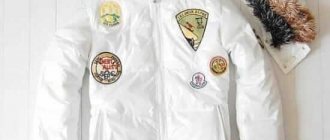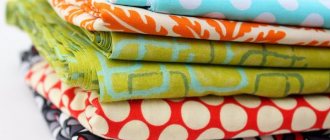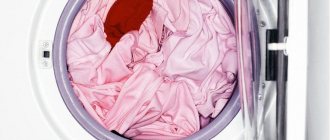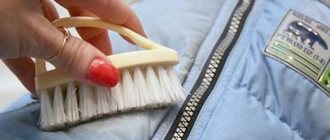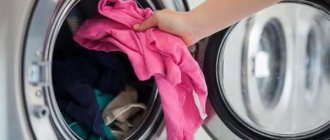Before any washing, it is always recommended to sort your items. This rule also applies to colored clothing.
To wash it, you should select special products. It is recommended to wash colored items according to the instructions.
Let's take a closer look at this process: how to wash colored items at home in a washing machine and by hand, at what temperature.
Possibility of joint processing
Not all colored fabrics can be washed together. It is important to consider two nuances. The first is the combination of colors of things, the second is the combination of materials from which they are made.
Products of different colors with each other
When washing several colored items, it is recommended to follow these rules:
You can wash items of similar color shades together. This applies to the combination of blue and green clothes, yellow and orange, red and pink.- You cannot put clothes made from contrasting fabrics together in the machine or wash them by hand. This applies to yellow and blue clothes, green and red, blue and orange, gray and orange, blue and pink.
- You can wash colored items made from the same or matching fabrics together. This applies to items made of cotton, linen, chintz and calico. It is allowed to put colored synthetic items in the wash together. It is permissible to wash cashmere and wool clothes together. You can combine clothes made of silk with synthetics.
- You cannot wash colored linen and cotton linen with synthetics together. This also applies to items made of wool and cotton, wool and linen.
Even if two items are the same color but made from different materials, they should not be washed together.
Together with black
It is recommended to process such products separately, especially if one of them is light in color . It may take on a different color when washed. Also, you should not combine black and colored underwear made from different materials. In this case, it may fade.
Colored and black clothes can only be washed together on two occasions at a time. Both items must be made from the same material or from two washable fabrics (cotton and linen). The colored product must be dark.
When washing black and dark blue or black and dark brown items, the second item will not be harmed in either case. Even if any color defect occurs, it will not be noticeable.
Is it allowed together with light?
Such items must not be co-washed under any circumstances . White linen almost always suffers from co-washing.
It often turns a different shade and becomes unwearable. When sorting clothes before washing, you should first separate colored items from white ones.
Read about how to properly wash white clothes here.
Preparing for washing
To preserve the structure, the initial color of the laundry must be sorted. It is strictly forbidden to wash colored, black, and white together if you want to preserve the originality of things.
White items without patterns or prints are placed separately, colored items are placed separately, and black items will be in the third pile.
Important ! Colored and black clothes are not washed together; these are two different categories of laundry.
When sorting, we pay attention to the quality indicators of the laundry:
- natural fabrics are washed separately from synthetics;
- undyed linen and cotton can be boiled if heavily soiled, but silk and other delicate fabrics will not survive this;
- Delicate fabrics are washed in the machine with the lowest possible spin; synthetics are washed better;
- Different types of fabric are cleaned with completely different cleaning agents, which can harm other types of fibers.
This should definitely be taken into account when storing laundry. Please note that it is not recommended to overload the machine; the quality of the cleaning process depends on this. The more the drum is loaded, the worse the clothes are washed.
Selecting a detergent
This type of product can be processed with both powders and gels . You can use capsules and soap.
It is recommended to choose powder in cases where a colored item needs to be cleaned from stains. This product removes dirt better. The powder is also recommended for use when colored clothes need to be washed by hand.
Capsules should be used in machine wash only. They are also suitable for soiled items. The dosage of powder in them is optimal. They also contain the required amount of stain remover.
Gels are more suitable for washing colored clothes in a machine. They should be chosen in cases where the fabric needs to be restored to brightness. Gels are only suitable for washing lightly soiled clothes. They are intended for use in non-hot water (up to 40C).
Laundry soap is recommended for use when soaking colored fabrics.
This product should be used when the laundry is heavily soiled or the stains have been on it for a long time.
Erase the black
How to wash black linen in a machine in order to preserve the color and remove dirt efficiently is not easy. You need to know some subtleties and secrets:
- dark-colored items are washed inside out;
- temperature conditions should not exceed 40 degrees;
- For washing, special liquid detergents are used that do not leave streaks.
Before washing clothes in the machine for the first time, it is better to fix the color. The product is soaked in a strong saline solution, then sent to the drum. The same effect is achieved by soaking the product in water and vinegar.
The main wash is carried out as usual, strictly following the recommendations.
Can the same gel or powder be used for white and multi-colored?
Any colored linen should not be washed with powder or gel for white items. These products contain bleach.
Often they may contain chlorine - such a substance negatively affects the quality of multi-colored linen . After washing, it may become less bright and saturated. It may appear stained.
White clothes can sometimes be washed with a powder intended for colored fabrics. But you shouldn't do this often. From constant washing, white linen may begin to turn gray or yellow over time.
Proper washing technology is the key to success
Do I need to soak laundry before washing it in the washing machine? The first thing you should pay attention to is the correctness of the process of washing bed linen. Of course, an automatic machine greatly simplifies the life of every housewife, because you just need to load things into it and turn on the desired cycle. However, the results of such washing are not always satisfactory. Therefore, to prevent collapses in the future, it is very important to wash dirty bed linen correctly.
This process consists of the following stages:
- Pre-soak using bleaches (for whites) or stain removers (for coloreds).
- Boiling using modern household chemicals.
But if, nevertheless, something went wrong and your bed linen has lost its color and turned yellow-gray, we offer you a number of effective methods that will help solve the problem.
Sorting and preparation rules
It is recommended to adhere to the following tips:
- First, sort the laundry by color. Separately lay out white, black and colored items.
- Carry out separate sorting of colored products. Place clothes of dark and light shades separately.
- Items sorted by color are divided depending on the type of fabric. You can group clothes made from cotton and linen, and put them separately from items made from wool and silk. Place synthetic items separately. Sort fine colored and lace underwear into a separate pile.
- Arrange items depending on their washing mode. Colored towels and bed linen are placed separately. They are washed at a higher temperature. Washing other items should be done at low temperatures.
- Sort products based on their degree of contamination. Very dirty clothes and items with old stains should be placed in a separate pile.
If items are heavily soiled, it is recommended to prepare them for washing by soaking. You can use laundry soap for this.
Rub it on the problem area of the item and leave it for an hour. You can also soak the entire item in soapy water for several hours.
Before any washing, multi-colored laundry must be turned inside out . This way it will better retain its color.
Black spots on bed linen: what to do?
Stains on bed linen are not always a sign of human biological secretions. Sometimes third parties are also involved in the process. One of these participants, which is very, very difficult to call pleasant roommates, are bed bugs. If you notice black spots and bloody marks on your bedding, then rest assured that you are almost certainly being attacked by bedbugs at night.
Fighting bed bugs is more than difficult. The fact is that they live in close proximity to a person, most often in a bed, but hide from human eyes. Most often, they choose mattresses, bed trays, spring blocks and other places that are difficult for humans to reach as shelters. This is what makes it difficult for humans when trying to get rid of these blood-sucking insects. And if at least one female remains alive, she is able to reproduce a new population of these little “monsters.”
Today we will figure out how to wash bed linen infested with bedbugs.
- If there are traces of blood on the bed linen, then the first step is to treat the product for this type of stain. How to do this has already been discussed in our article.
- Next, the contaminated laundry must be loaded into the washing machine separately from other items. Choose temperatures above 60 degrees to kill bed bugs in all stages of development, from adults to larvae.
- After washing, treat the laundry with hot steam using an iron or steam cleaner.
Washing instructions
These clothes can be washed both by hand and in a machine. For each method, the water temperature is selected. In the first case, the products may become soaked. It is also important to rinse and wring them out correctly. In the second case, you need to select the desired washing mode.
In the washing machine - at what temperature?
To effectively wash things in a machine, you need to:
Place pre-sorted and, if necessary, soaked laundry in it.- Pour powder into the compartment or pour gel into it. If a capsule is used for washing, then it must be placed in the machine drum itself.
- Set the setting to delicate mode.
- Disable spin mode.
- Wash clothes at a temperature not exceeding 40C.
After washing, the laundry is immediately pulled out of the machine and sent to the dryer. You should not leave it in the washing machine for a long time.
Manual cleaning - at how many degrees?
To effectively wash things by hand, you need to:
- Fill a basin with water. It should be at room temperature. It is allowed to use water at a temperature of 300C and a maximum of 400C.
- Pour the powder into the basin. Its dosage is determined taking into account the number of things.
- Place clothes in the basin. If it is very dirty, you can soak it in a basin for 1-2 hours. You can also additionally rub problem areas with laundry soap.
- After soaking, it is recommended to change the water in the basin and add fresh powder to it.
- Wash things by hand by gently rubbing them. Pay special attention to the armpits and collar areas.
- Drain the water from the basin. Wash it and pour cool water into it. Rinse washed textiles thoroughly in it.
- Lightly wring out the clothes and hang them to dry.
When washed by hand, laundry wears out much more slowly than when washed by machine.
Washing dirty laundry
Each housewife uses her own methods when washing bed linen. Before starting this event, you need to prepare the laundry itself: turn everything inside out, clean the corners of threads and dust. It is recommended to temporarily sew up the hole in the duvet cover. Manual or automatic washing method must be chosen based on the color, quality of the fabric and degree of soiling.
Machine washable
The machine can be used to wash bed linen made of any fabric. The main thing is to set the mode and water temperature correctly:
- for cotton, a temperature of 60 degrees is suitable;
- if it is satin or linen, then it is necessary to set it to 40 degrees;
- Silk and satin must be hand washed at a temperature of only 30 degrees.
If the laundry is not yet sufficiently dirty, you can start washing immediately. If everything is worse, then you need to pre-soak it and add a little powder. The soaking process should last about three hours.
Washing bed linen by hand
This method is much more difficult. The first step is soaking. The duration of the procedure is about an hour. The laundry must be completely immersed in water. Then it is twisted out, and the water is changed to hot with the addition of powder or gel. We wait another half hour until the powder dissolves and you can start washing.
The pillowcases need the most attention. After all, it is this component of bed linen that gets dirty more than others. Once everything has been wiped, you can start rinsing. This is the hardest part of hand washing. The water should be replaced with cold water. You should first rinse in a basin and then under running water. And finally, wring out the laundry.
Difference for new and old clothes
New multi-colored items can be washed frequently . It is recommended to do this much less frequently with older products, because they are already quite worn out.
New textiles can be washed both by hand and in a machine. For old ones, hand washing is more suitable. It is gentle and extends the service life of the product.
New colored linen can be washed in a variety of detergents. For washing old clothes, it is recommended to choose gels . Powders wear out products faster. Gels extend the life of such items and slightly improve their color.
If new clothes can be washed at a temperature of 40C, then it is better to wash old and worn ones at a maximum of 30C. At this temperature, it will be able to serve for some time.
Read the article about whether you need to wash new things after purchasing them.
Folk ways to deal with washed laundry
Despite the lack of washing machines and expensive modern laundry detergents, the bed linen of our grandmothers and mothers was snow-white and smelling pleasant. So what is the secret of such success? There are several very effective methods that our parents actively used and thanks to which the problem of how to wash washed bed linen simply did not arise.
Baking powder or starch
This is a great way to return your pillowcase, duvet cover and sheets to their former whiteness and freshness. To do this, you need to soak the laundry in a solution that is prepared in the ratio of 1-2 tablespoons of starch or baking powder per 5 liters of water.
Important! When rinsing laundry in a starch solution, you don’t have to rinse it in clean water later. Starch will give it smoothness and pleasant softness.
Another option is to put the starch directly into the washing machine drum. Most of those who have tried this method praise it and say that the effect is no worse than when rinsing in a solution.
Boric acid
This remedy can be easily found at the pharmacy. It is used by housewives to enhance the cleanliness of things and is a kind of “conditioner” during the rinsing process. To do this, 1-2 tablespoons of boric acid must be diluted in 3 liters of fairly warm, but not hot water. Finally, rinse the laundry in clean water.
Important! Please note that the process of rinsing things should take 3-10 minutes, no more.
Ammonia
In especially severe cases, when washing washed bed linen, ammonia can come to your aid. This product is very effective when pre-soaked. The most important thing is that the water is hot enough, about 70 degrees.
Important! Try not to use ammonia alone, but add various additives to the rinsing solution, such as salt, hydrogen peroxide or baking soda.
In addition, a solution with ammonia is very effective in boiling down bed linen. The most important thing is not to be in the kitchen at this moment, as harmful fumes are released that can harm your health.
Nuances for different fabrics
It is important to consider the following differences in washing colored items made from different materials:
- It is better to wash cotton and linen at a maximum of 40C;
- silk products must be washed only by hand at a maximum water temperature of 30C;
- silk cannot be wrung out, as it forms folds that are difficult to smooth out;
- silk products cannot be rubbed, only handling the material with your hands is allowed;
- woolen items can only be washed by hand at a temperature of 20C;
- When washing colored wool, use only soap;
- It is better to wash wool blend products in a machine on a delicate cycle;
- colored synthetics can be washed by hand and in a machine, but at low temperatures (30C is enough).
It is better to wash linen and cotton fabrics with laundry soap. It is recommended to wash colored wool, silk and synthetics with liquid soap.
Recommendations for drying and ironing clothes
You need to dry your laundry in natural conditions, hanging it on a line. It’s good if the space allows you to neatly straighten the sheets and duvet covers. Then ironing will take less time, effort, and electricity.
Rules for easy ironing of bed linen:
- Remove slightly damp cotton and linen bedding from the lines or spray it with moisture when ironing;
- There is no need to spray water on silk underwear, as stains may remain. Iron it on the lowest temperature;
- Leave the ironed laundry for 20 minutes to air it out, cool to room temperature, and only then put it in the closet.
- Terry sheets should not be ironed.
When is ironing required?
It is believed that bed linen must be ironed:
- For guests who spend the night in your home;
- For infants and children under 7 years of age to disinfect;
- For a sick person, it is advisable to boil sheets, duvet covers and pillowcases and iron them at the maximum permissible temperature.
We remove different types of stains
On shirts and T-shirts, yellow spots most often appear in the armpit area. Also, traces of drinks often remain on things. Often there is a need to wash things from rust and grease stains. Contamination from pens and felt-tip pens is especially corrosive.
Yellow under the arms
To remove traces of sweat from things, it is recommended to use alcohol. To do this you need:
take 96% alcohol and dilute it in water - just dilute 120 g of alcohol in 220 g of water;- soak a cotton pad in the solution;
- apply it to the yellow spot around the entire perimeter;
- wait a couple of hours;
- wash the product.
It is allowed to add a small spoon of salt to the alcohol solution.
From drinks
To remove traces of tea from things, it is recommended to use vinegar.
- Take a large spoon of vinegar and mix it with ½ small spoon of dish soap.
- Stir the mixture.
- Treat the stain with it.
- Wait 15 minutes.
- Rinse off with tap water.
Coffee stains are best removed with a mixture based on vinegar, washing powder, grated laundry soap and warm water.
One small spoon of each component is enough.
All of them are mixed and applied to the dirt. The mixture is washed off after 20 minutes. Wine stains can be removed with ammonia . It is necessary to generously saturate a cotton pad with it and carefully wipe the wine mark. You need to wait 10 minutes. After this, the procedure can be repeated, and then washed.
From rust
Such stains should be removed with lemon juice.
To do this you need:
- pour 5 large spoons of lemon juice and the same amount of cold water into a wide glass;
- dip clothes into the solution at the place where there is a rusty stain;
- wait 15 minutes.
At the end, you need to rinse the item under running cold water and wash it with powder.
From fat
To get rid of grease stains, use salt and laundry soap:
- Soak the greasy stain with a paper towel.
- Sprinkle salt generously on it and leave for 5 minutes.
- The stain is rubbed with laundry soap and covered with a plastic bag.
- The item is left for half a day.
After processing, the product is washed in a machine or by hand.
From pen and felt-tip pen
Products for removing marks from pens and felt-tip pens are selected taking into account the basis of these writing instruments:
If the pen or felt-tip pen is water-based , then stains from them can be washed off with laundry soap or ammonia.
Just rub the item with a bar of soap, wait 15 minutes and rinse with cold water. If ammonia is used, then use a cotton pad soaked in it to thoroughly treat the stain, and then rinse the product with cold water.- If a pen or felt-tip pen has a fat base , then stains from them are removed with vegetable oil. The item is wiped with a cotton swab dipped in it. After this, the product must be washed with powder.
- Stains from pens and felt-tip pens, which are based on paint filler , can be washed off only with solvents. It is necessary to treat the contamination with a cotton swab soaked in acetone. This should only be done for a couple of minutes. Then the product must be washed.
Traces from an alcohol felt-tip pen are removed with a mixture of medical alcohol and grated laundry soap.
Both components are mixed to a paste. The paste is applied to the stain and rubbed in with a toothbrush. After this, the clothes need to be washed with powder.
How to remove yellow stains from sheets and pillowcases?
Yellow stains often appear on white bedding and sheets. If you later find yellow spots on the sheet, then there may be several reasons for the appearance of such spots. These include:
- Sweat stains
- Incontinence spots
- Sperm stains
- Spit stains.
Sweat stains
During sleep, every healthy person secretes about half a liter of fluid, since the sweat glands work as usual. In addition, if certain conditions are violated, a person may sweat even more than usual, quite profusely. This type of sweating is directly related to the health status of a person. For example, with taking certain medications, with the development of a disease, and so on. Overweight people, people suffering from hormonal imbalances, pregnant women, etc. sweat profusely. Also, the process of sweating is associated with such primary factors as the temperature outside the window and directly in the room. That is why it is important to create a comfortable atmosphere in order to sleep healthy and soundly.
Urine stains
One of the most unpleasant problems for adults and a fairly common situation among children. Incontinence in adults is a serious disease that requires appropriate treatment and a comprehensive solution to the problem. However, if problems of this nature do not bother you, and small children simply live in your house, then you need to know how to get rid of stains of this kind on linen. The main thing is to do this in a timely manner so that the unpleasant odor does not spread throughout the apartment and is not absorbed into the deep layers of the mattress.
Sperm stains
You've probably noticed stains on the sheets after sex. Since sexual intercourse involves the release of sperm, in cases where ejaculation occurs on bed linen, yellowish spots may remain on it. In addition, a similar problem affects young people, namely boys in the process of puberty. Nocturnal emissions, which cause the release of sperm, can also leave yellow stains, which are especially noticeable on white and light-colored bedding.
Spit stains
Spit stains on pillowcases are a common problem among teething babies. Some adults also like to "drool" at night. There are many reasons for this: from malocclusion to relaxation of the lower jaw during sleep. If a person has such disorders from birth, then most likely finding a pillow wet from drool in the morning is already a common procedure. There are also some factors that can provoke increased salivation in a person: these include bad habits such as smoking and drug use, as well as acute respiratory viral infections and influenza. A simple runny nose can cause increased salivation.
Restoring color brightness at home
For products of different colors, different means are suitable to maintain their brightness:
- rinse yellow, pink and blue fabrics in a 9% vinegar solution (125 ml of vinegar per 6 liters of water);
- Rinse blue and red clothes with soda (add a small spoon of soda per liter of water);
- rinse green laundry in a solution based on alum (one large spoon of alum per 5 liters);
- Rinse brown and cream clothes in a solution based on tea leaves (its color is selected taking into account the tone of the item).
You can add the same brightness to blue clothes using blue. It dissolves in water to a shade that matches the color of the item.
Recommendations from experienced housewives
Colored clothes cannot be washed with white and black - otherwise all things will be spoiled. While many people know this rule, only a few know the other nuances of washing brightly colored clothes. We suggest you solve problems by getting acquainted with the recommendations of experienced housewives.
The first tip is to wash colored clothes in soft water. You can do a test: add 25 g of soap to 250 ml of boiling water. If the latter quickly dissolves without a residue, there are no problems with hardness. Otherwise, you need to purchase a special softener or add soda every time you wash.
To wash colored laundry, you need a detergent without bleaching ingredients!
Particular attention is paid to soaking. If you immerse colored tights and socks in a solution of water and boric acid for an hour, the stains will go away faster and the shade will not be affected. When washing workwear or heavily soiled items, rub them with a mixture of laundry soap, boiling water, soda, kerosene and leave for 7-8 hours.
There are some more tips:
- When washing linen items, add vinegar and rinse in cool water;
- rinse pink, yellow and blue in vinegar water;
- Rinse red and blue in salted water.
Multi-colored mohair products are rinsed using a special technology. So, for rinsing, three tablespoons of glycerin are diluted in water. The component will fix the shade and give the fabric softness and smoothness.
How to dry?
Linen should not be left to dry in the sun . Under the influence of its rays, the thing fades faster and loses its brightness.
Products must be hung to dry in a dark place. Before doing this, they need to be turned inside out. When drying, it is better to keep things of contrasting colors at a distance from each other.
Basic rules for drying clothes after washing can be found here.
You will find maximum useful information about washing clothes and various fabric products here.

